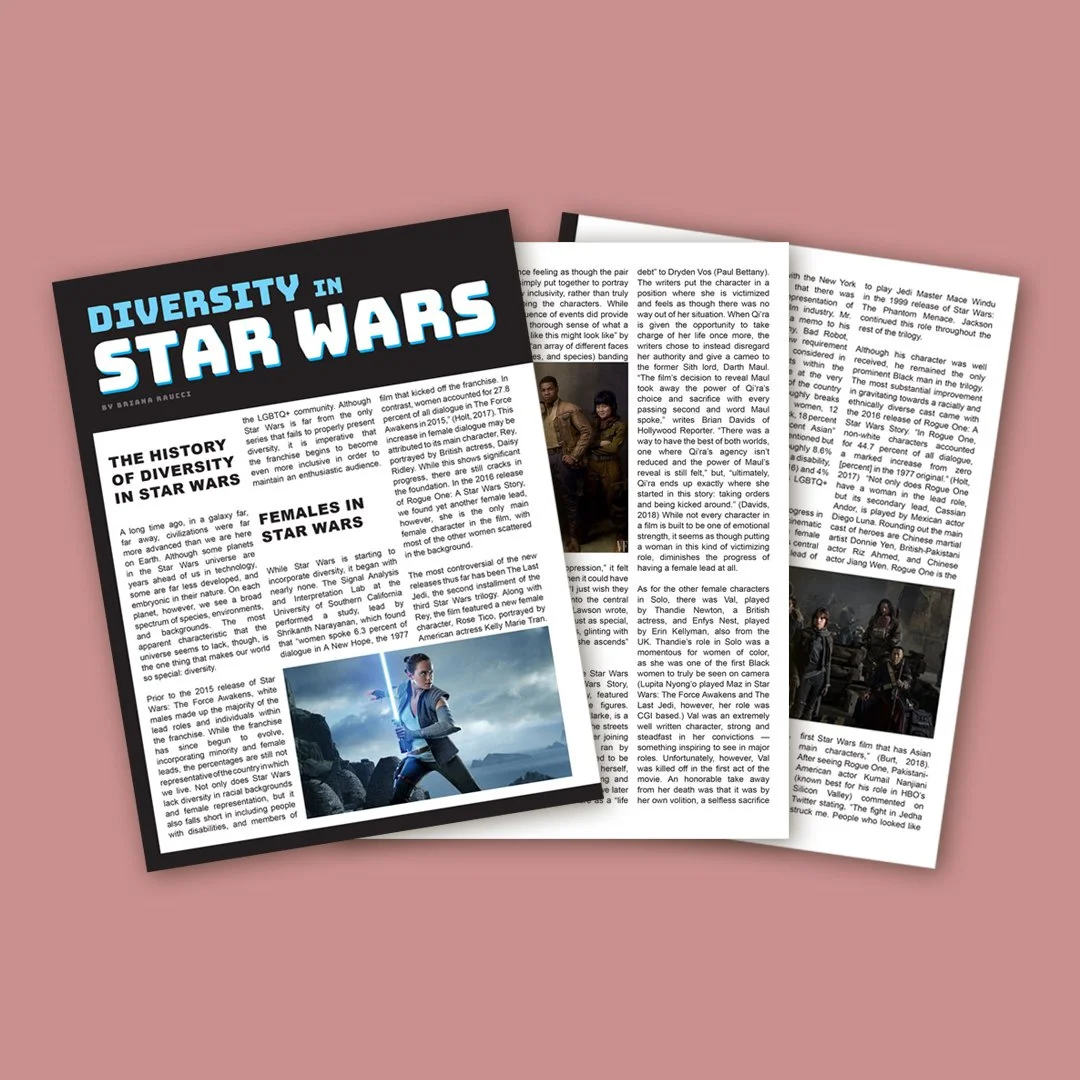Diversity in Star Wars
In 2016 while obtaining my Master’s degree from Quinnipiac University, I took a writing class in which we chose a theme to write about for the entire semester. Naturally, I wrote about Star Wars.
Being passionate about diversity, equity, and inclusion (not in the superficial sense that companies love to market today out of convenience), I wrote an article about the history of diversity in the larger-than-life franchise. I addressed female representation, racial diversity, disabilities in Star Wars, LGBTQ+ representation, and more.
I’d like to offer an excerpt from it, and encourage you to read the article. Thanks in advance for reading!
From my article
The Infamous Checklist
While diversity and inclusivity is extraordinarily important, it is also vital that it happens organically. When attempting diversification, it has been realized that some companies, organizations, and groups end up falling for “the quota.” Diversity can easily turn into a checklist, rather than a factor that allows creativity to flourish and develop into more realistic, engaging and truly rich stories. When the checkbox is used to write new material, the quality of the narrative drops significantly, and can actually become offensive. The characters turn into “one-dimensional, blink-and-you’ll-miss-’em characters that generally are given only a few seconds of screen time,” (Peyton, 2017).
So how do you create films, novels, games, and comics that are genuinely diverse and inclusive? Writing characters with varied backgrounds seems like the obvious answer, however, the issue stems back further in the process. The life that needs to be breathed into the franchise will come from hiring a diverse group of people to work together to create the stories. While the exact translation of the quote remains debatable, and the source itself has become a paradox, it has been reported by Plato that the great Greek philosopher Socrates once said something to the effect that, “what I do not know I do not think I know either,” which means that you don’t know what you don’t know. If you haven’t had certain experiences in life, you might not know those experiences even exist. Yes, most of us can imagine a lot of things, but not everything. Bringing in a group of people who have had truly different and varied life experiences based on their backgrounds, will be the defining factor in creating rich and immersive stories. The differences in people's understanding of life is what, when collaborating with one another, will deliver the kind of diversity that fans are looking for.
Just because women do not play as big of a role in Star Wars as men, does not mean that it should turn into all women either. A story group made up of only women might not understand the trials and tribulations that men have to deal with. In The Last Jedi, it almost seems as though the male characters were made to be more brash and foolish in order to emphasize the intelligence and strength of the women. Things like this are counter productive, as it is unnecessary to put one down to show the strengths of another. While these might seem like intimidating characteristics to achieve, they would come naturally with diverse story groups, producers, filmmakers, and directors – without such, it again, becomes a disingenuous checklist and quota.
Monetary Inspiration
With the extreme criticism of newer, more diverse characters, it becomes intimidating for writers, producers, directors, and actors to want to partake in becoming more diverse, however, newer studies actually show that it is in their best interest – financially. Of course, while the moral implications of diversity are the goal, money is what always does the talking. If money is what will help move the franchise towards genuine inclusively and richer storytelling, the Creative Artists Agency has proved through a study and database “that across every budget level a film with a diverse cast outperforms a release not so diversified.” (Anderson, 2018)
The contraction to this is that in some countries, such as China, diversity and showing characters that are LGBTQ+ are not acceptable and often censored. However, “In 2015, China accounted for just six percent of The Force Awakens’ global gross. Had the film never opened in China, it still would have earned $2 billion—a total surpassed only by Avatar and Titanic,” (Payton, 2017) so this does not appear to be a good reason not to take the step towards diversification.
Diversifying the Industry
This article does not claim to have gotten everything right. Points might have been missed, subjects may not have been touched upon as thoroughly as they could’ve been, but it is to serve as a reminder that progress is imperative, attempts and steps taken towards inclusivity and diversity should be recognized, and efforts in doing such should be encouraged to inspire more change and further benefit all people. Change never has, and never will occur without vocalization of the issues. Although no one person, company, organization, or group will ever be perfect and get it all right, it is still important to do the best conceivable job possible, to make sure everyone knows the value they hold, and can be inspired and empowered to make those positive changes themselves.
These changes do not just apply to the Star Wars franchise by any means – it is important to recognize and appreciate the advancements the franchise has made since it’s early beginnings; but to also support and have faith that they will be able to successfully accomplish the implementation of more diverse and inclusive stories and characters. Hopefully, these changes will inspire others and promote growth not only in the film industry, but also in the world as a whole - serving as a highly regarded example for progress. It is key to remember that change does not happen overnight as well; it will continue to be a growing process for the franchise, as long as Star Wars shall live. Where it goes will be a surprise to be sure, but a welcome one.
